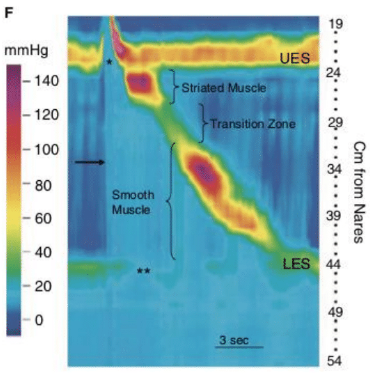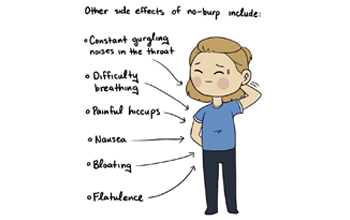Swallowing information for Oesophageal Dysphagia.
Definition:
Swallowing is a complicated sequence of both voluntary and reflex movements, which needs your brain to coordinate many muscles and nerves.
Dysphagia is the medical term for a sensation of difficulty or abnormality of swallowing. It can happen rapidly, or slowly and has many causes.
The Oesophagus (also spelt esophagus) is a distensible tube, almost 20cm long, connecting the pharynx and stomach. It is separated from the pharynx by the upper oesophageal sphincter (UOS) and from the stomach by the lower oesophageal sphincter (LOS). Under resting conditions the oesophageal tube is collapsed, a potential space that can distend easily to accommodate air, liquids or solids.
The act of swallowing pushes the food or fluid through the pharynx and opens up the UOS to allow it to enter the oeosphagus. This initiates oeosophageal peristalsis, or a sequential wave of muscle contraction down the length of the oesophagus, pushing the swallowed bolus into the stomach.
When swallowing problems occur in the oesophagus, this is referred to as Oesophageal dysphagia.
Causes:
Oesophageal dysphagia can be caused by a variety of structural or neuromuscular (motility) disorders. Motility disorders are generally only considered the cause of dysphagia and/or chest pain, after structural disorders have been excluded.
| Structural | Neuro-muscular |
|---|---|
| Stenosis & Strictures (i.e. narrowing) | Achalasia (i.e. a poorly relaxing LOS and lack of contraction of the oesophagus) |
| Webs | Diffuse Oesophageal Spasm |
| Diverticulum | Nutracker Oesophagus |
| Oesophagitis (i.e. inflammation) | Scleroderma |
| Cancer | Ineffective Oesophageal Motility |
| External Compression (e.g. enlarged thyroid or vessels) |
A detailed discussion on the individual disorders above is beyond the scope of this information sheet.
Diagnosis:
The diagnosis of dysphagia involves a thorough case history, clinical examination of the muscles and nerves required for swallowing, digital nasendoscopy of the upper airway and pharynx, and an instrumental swallowing evaluation such as Flexible Endoscopic Evaluation of Swallowing and/or a Video fluoroscopy Swallowing Study (x-ray).
Additional tests may be required such as a standard barium swallow, Trans-nasal Oesophagoscopy or gastroscopy, High Resolution Oesophageal Manometry (SEE Fig. 1), 24 hr pH/ Impedance monitoring and/or salivary pepsin testing. A validated questionnaire, called a patient-related outcome measure, is often completed initially, and repeated later on to measure your progress. E.g. Eat-10 or SWAL-QOL.

Fig. 1 – Esophageal Pressure Tomogram from Hi Resolution Impedance Manometry
Oesophageal disorders are usually best identified and classified with a combination of direct visualisation / video-fluoroscopy / Barium Swallow and High Resolution Impedance Manometry.
Symptoms of oesophageal dysphagia you might experience include:
- A sensation of food “sticking” during swallowing (persistent or intermittent) anywhere from mid-chest to neck region
- Greater difficulty swallowing solids than liquids
- Coughing up food/pills after the swallow
- Needing to drink fluids to wash down the meal.
- Pain or discomfort in the neck or chest region
- Reflux or heartburn
- Regurgitation of undigested food
- Unexplained weight loss.
If you can’t swallow correctly then food and drink may be getting into your airway and lungs. This is called aspiration. If this happens it can lead to infections and pneumonia, which can be very serious. It is important that any changes to your swallowing are identified early, to avoid this happening.
Management:
Once you have had a complete swallowing evaluation, the swallowing specialists can recommend ways to improve your ability to eat and drink depending on the specific problems found:
- Specific Treatments: These will be tailored to the underlying condition diagnosed, but could include:
- Medications: should always be administered under the supervision of a physician.
- Muscle Relaxants: These include Calcium Channel Blockers, Nitrates, Phosphodiesterase Inhibitors, and may be used for disorders of increased oesophageal contraction/spasticity: medications
- Pro-kinetics: These are medications that increase the frequency and strength of contraction in the oesophagus, and include: Bethanachol, Pilocarpine & Domperidone. They may be used for disorders of decreased oesophageal contraction/hypo-motility
- Anti-Reflux: These medications reduce the amount of acid produced by your stomach or neutralise the acid produced. They include: Omeprazole, Pantoprazole, Ranitidine, Gaviscon®. They may be prescribed where it is thought that acid reflux is contributing to the disorder – e.g. Oesophagitis, or Ineffective Oesophageal Motility.
- Procedures:
- Serial Balloon Dilation – this may be employed for structural narrowings (e.g. strictures/webs) or motility disorders in which there is a failure of relaxation of the lower oesophageal sphincter ; it is performed endoscopically.
- Botulinum Toxin Injection: If you have a focal muscular spasticity, this may be able to be treated with a procedure to improve relaxation in your oesophageal muscles
- Heller Myotomy – this is an endoscopic operation in which the lower oesophageal sphincter +/- oesophageal muscle is incised to decreased hyper-motility, over-contraction.
- Medications: should always be administered under the supervision of a physician.
- Dietary Modifications
- Choosing soft/moist foods with extra sauces/ gravies.
- Reducing the amount of fatty foods, alcohol, nicotine and caffeine in your diet (these relax the LOS and contribute to reflux)
- Reduce carbonated drinks, citrus and spicy foods (these may irritate the oesophageal lining and contribute to reflux)
- Referral to other specialist
- You may need to see another swallowing specialist called a gastroenterologist or Upper Gastro-Intestinal Surgeon – to further examine the oesophagus and stomach.
- They too will have specific treatments for you, depending on your symptoms.
Initial recommendations:
- Take your time when eating and drinking
- Take smaller mouthfuls and chew food thoroughly
- Alternating food and fluids to wash meal down
- Eat smaller meals more often.
- Remain sitting upright for 2-3 hours to optimise digestion and avoid reflux.
- Ask your GP or physician today whether you need a swallowing examination.

